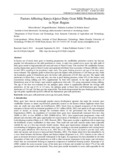Factors Affecting Kenya Alpine Dairy Goat Milk Production in Nyeri Region
Date
2014-11-06Author
Mburu M.
Mugendi, Beatrice J.
Makokha, A.
Muhoho, S.
Metadata
Show full item recordAbstract
In Kenya use of exotic dairy goats in breeding programmes for smallholder production systems has become popular, but information on the milk production is scarce. A study was carried out to assess the milk yield of dairy goats reared in high potential and semi arid areas of Nyeri County. This involved 190 smallholder farmers rearing Alpine dairy goats in Nyeri County and registered with Dairy Goat association of Kenya (DGAK), which formed 100% sampling of the population under study. The grade, feeding practices and age of the dairy goats were evaluated. The appendix grade in Kieni East gave the highest milk production of 2.69 liters per day, while the foundation grade in Mukurweini gave the lowest milk production of 0.98 litres per day. The higher milk production in Kieni East, a semi arid area, was due to good feeding practices, where 43% of the farmers used concentrates during milking and 48% supplemented the feed with minerals. In the high potential area of Mukurweini none of the farmers used mineral supplements with only 13% using concentrates during milking. The age of the dam was evaluated for the pedigree grade, where it significantly affected the average milk production. At the age of 5.0 to 5.9 years, the pedigree grade in Kieni East and Mukurweini gave highest production of 2.84 and 2.96 liters per day respectively. The results demonstrated that poor feeding practices, damage and grade, significantly (p≤0.05) affected the Alpine dairy goat milk production.
URI
http://hdl.handle.net/123456789/2735http://repository.dkut.ac.ke:8080/xmlui/bitstream/handle/123456789/194/Factors%20Affecting%20Kenya%20Alpine%20Dairy%20Goat%20Milk%20Production.pdf?sequence=1
http://www.ccsenet.org/journal/index.php/jfr/article/view/37712
Collections
- Journal Articles (PAS) [303]

